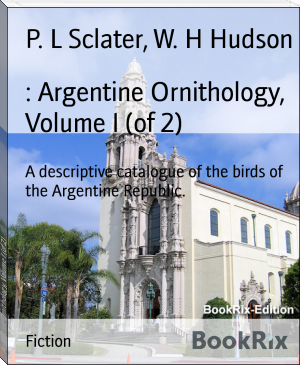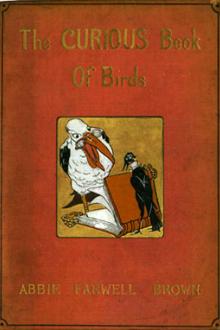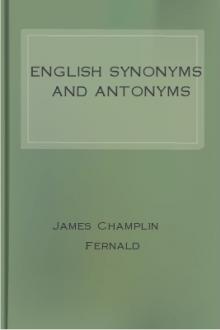: Argentine Ornithology, Volume I (of 2), P. L Sclater, W. H Hudson [best authors to read txt] 📗

- Author: P. L Sclater, W. H Hudson
Book online «: Argentine Ornithology, Volume I (of 2), P. L Sclater, W. H Hudson [best authors to read txt] 📗». Author P. L Sclater, W. H Hudson
however, on small caterpillars and spiders, for which it searches
diligently among the leaves, after the manner of the Wren. Although
belonging to the songless division of the Passeres, this small
Tyrant-bird possesses a formal song, which the male utters with
great frequency, the only other member of the Tyrant-family that I
am acquainted with which really sings being the Scarlet Tyrant
(_Pyrocephalus rubescens_). The music of the Reed-Tyrant is weak but
curious; it is composed of five brief percussive notes, distinctly
metallic in sound, which may be imitated by gently and slowly striking
_fa la mi sol fa_ on the highest keys of the piano. To utter this quaint
little song the bird perches itself on the summit of a weed or bush,
where it solicits attention with a little chipping prelude, and then
jerks its head vigorously with each note, delivering its few drops of
sound with all the assurance of a master in the art of melody.
In October it builds a deep elaborate nest of fine dry grass,
thistle-down, webs, feathers, and other soft materials, usually in the
fork of a weed or thistle three or four feet from the ground. It lays
four cream-coloured eggs, the colour deepening to grey at the larger
end.
142. HABRURA PECTORALIS (Vieill.). (THIN-TAILED TYRANT.)
+Fluvicola albiventris+, _Scl. et Salv. Nomencl._ p. 43; _Durnford,
Ibis_, 1878, p. 59 (Buenos Ayres).
_Description._--Above black; front half of head, narrow band across
the rump, and slight edgings to wing-coverts and outer secondaries
white; below white; bill and feet black: whole length 5·5 inches,
wing 2·8, tail 2·2. _Female_ similar.
_Hab._ Amazonia, Bolivia, and Argentine Republic.
The small black-and-white Tyrant is not uncommon in the marshes and on
the river-margins in the Plata district, its spring migration extending
south to Buenos Ayres. Like the Kingfisher, it haunts the water-side and
is found nowhere else. It has a shy, retiring disposition, concealing
itself in the close thickets overhanging a stream, so that one does
not often see it, notwithstanding its conspicuous white plumage. When
disturbed it emits a series of low ticking notes, or darts swiftly out
from the thicket, showing itself for a moment over the water before
disappearing once more into its hiding-place.
D'Orbigny says it makes a purse-shaped nest, of slender twigs, moss, and
feathers neatly interlaced, and lays four white eggs, spotted at the
large end with brown.
121. ARUNDINICOLA LEUCOCEPHALA (Linn.). (WHITE-HEADED TYRANT.)
+Arundinicola leucocephala+, _d'Orb. Voy., Ois._ p. 334 (Corrientes).
_Description._--Black; whole head and neck and a patch on the flanks
white; bill horn-colour, base of lower mandible white; feet black:
whole length 5·0 inches, wing 2·5, tail 1·8. _Female_ above
cinereous; front and sides of head whitish; tail black; beneath
white, flanks and under wing-coverts cinerascent.
_Hab._ Colombia and southwards to Argentina.
This species, which is of wide distribution, was met with in Corrientes
by d'Orbigny.
122. ALECTRURUS TRICOLOR, Vieill. (COCK-TAILED TYRANT.)
+Alectrurus tricolor+, _Scl. et Salv. Nomencl._ p. 43.
_Description._--Above black, rump greyish; sides of the head,
scapularies, lesser wing-coverts, and outer margins of secondaries
white; tail black, outer rectrix on each side produced, expanded,
fan-shaped; below white, patch on each side of the breast (forming
an incomplete collar) black; bill horn-colour; feet black: whole
length 7·2 inches, wing 2·8; tail, outer rectr. 2·5, middle rectr.
1·5. _Female_: above brown, rump and lesser wing-coverts pale;
beneath dirty white, sides of breast brown.
_Hab._ S. Brazil, Paraguay, Uruguay, and Argentine Republic.
This species generally resembles the one next described, and has, like
it, a black, white, and grey plumage. But the tail, although strange, is
constructed on a different pattern. The total length of the bird is five
and a half inches, the tail being only two and a half. The two outer
tail-feathers have remarkably stout shafts, with broad coarse webs, and
look like stumps of two large feathers originally intended for a bigger
bird, and finally cut off near their base and given to a very small
one. In the male these two feathers are carried vertically and at right
angles to the plane of the body, giving the bird a resemblance to a
diminutive cock; hence the vernacular name 'Gallito,' or Little Cock, by
which it is known.
I have not observed this species myself, but Azara has the following
paragraph about its habits:--"The male sometimes rises slowly and almost
vertically, with tail raised, and rapidly beating its wings, and looking
while ascending in this way more like a butterfly than a bird; and when
it has reached a height of ten or twelve yards, it drops obliquely to
the earth and perches on a stalk." He adds that the males are solitary,
but several females are sometimes seen near together, and that the
females are greatly in excess of the males.
123. ALECTRURUS RISORIUS (Vieill.). (STRANGE-TAILED TYRANT.)
+Alectrurus guira-yetapa+, _Scl. et Salv. Nomencl._ p. 43; _Durnford,
Ibis_, 1878, p. 60 (Buenos Ayres). +Alectrurus risorius+,
_Barrows, Bull. Nutt. Orn. Cl._ viii. p. 140 (Entrerios).
+Alectrurus psalurus+, _Burm. La-Plata Reise_, ii. p. 457 (S.
Luis).
_Description._--Above black, rump grey; front varied with white;
wings black, scapularies, outer margins of wing-feathers and coverts
white; tail black, two outer rectrices much elongated, denuded at
the base, with a broad inner and no outer vane; below white, broad
band across the breast black; throat in the breeding-season bare of
feathers and of a bright orange; bill yellowish; feet black: whole
length 11·0 inches, wings 3·0; tail, outer rectrices 8·0, middle
2·0. _Female_: above brown, wings varied with white; beneath white;
breast-band pale brown; tail with the two outer rectrices slightly
elongated and denuded, terminated with spatulations on the inner
vane.
_Hab._ S. Brazil, Paraguay, Uruguay, and Argentine Republic.
Azara named this species _Cola estraña_ (Strange-tail), but mentions
incidentally that its Guarani name is 'guira-yetapá' (Scissor-tail), a
term which the Indians apply indiscriminately to several species having
the same sort of tail.
The Guira-yetapá is a very curious little bird, with a black, white, and
grey plumage and the beak of a true Tyrant; but it differs from all its
congeners in having the skin of the chin, throat, and sides of the head
bare of feathers, and these parts in the breeding-season are a bright
orange colour. It is a feeble flier, its wings being very short, while
the two outer tail-feathers are abnormally long and peculiar in form.
Mr. Barrows says:--"The remarkable condition of the outer pair of
tail-feathers is interesting. In the male these two feathers reach a
length of nearly ten inches, the rest of the tail being about three
inches in length. The vane on the _inner_ side of each is wanting for
the first two inches, and then suddenly develops to a width of nearly
two inches, which it maintains almost to the tip, when it gradually
narrows. The vane on the _outer_ side of the shaft is only about
one-quarter of an inch wide, and is folded so tightly against the shaft
that it is quite inconspicuous. In the only two males of this species
which I have seen flying, these long feathers seemed to be carried
folded together _beneath_ the rest of the tail, and stretching out
behind like a rudder or steering-oar, their vanes at right angles to
the plane of the rest of the tail."
Mr. Gibson gives a different account, and says the flight is singularly
feeble, resembling the fluttering passage of a butterfly through the
air, while the tail streams out behind.
It inhabits Paraguay, Uruguay, and the eastern portion of the Argentine
Republic, ranging as far south as the pampas in the neighbourhood of
Patagonia. It is usually seen singly or in pairs; Azara says he saw a
flock of thirty individuals, but as they were all _females_, it may be
that in this species, as in _Lichenops perspicillata_, the females are
sometimes gregarious, and the males always solitary. It frequents open
places, such as the borders of marshes, or plains covered with tall
grasses, and perches in a conspicuous place, from which it darts at
passing insects like a Flycatcher.
Mr. Gibson found its nest on the ground amongst herbage, and describes
it as a neat structure of dried grass, containing three white eggs with
a faint cream-coloured tinge.
124. CYBERNETES YETAPA (Vieill.). (YETAPA TYRANT.)+Cybernetes yetapa+, _Scl. et Salv. Nomencl._ p. 43; _White, P. Z. S._
1882, p. 604 (Itapua, Misiones).
_Description._--Above hoary grey, with lineiform blackish
shaft-stripes; wings black, with large chestnut-brown patch
occupying the outer webs of the inner primaries; tail of twelve much
graduated feathers, black; outer web of external rectrices white;
beneath same as above, but rather paler; throat and crissum white;
patch on each side of the neck, and collar across the neck dark
chestnut-brown; under wing-coverts and inner webs of wing-feathers
white; bill pale brown; feet black: whole length 16·0 inches, wing





Comments (0)